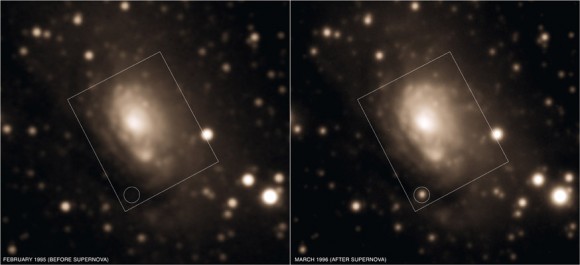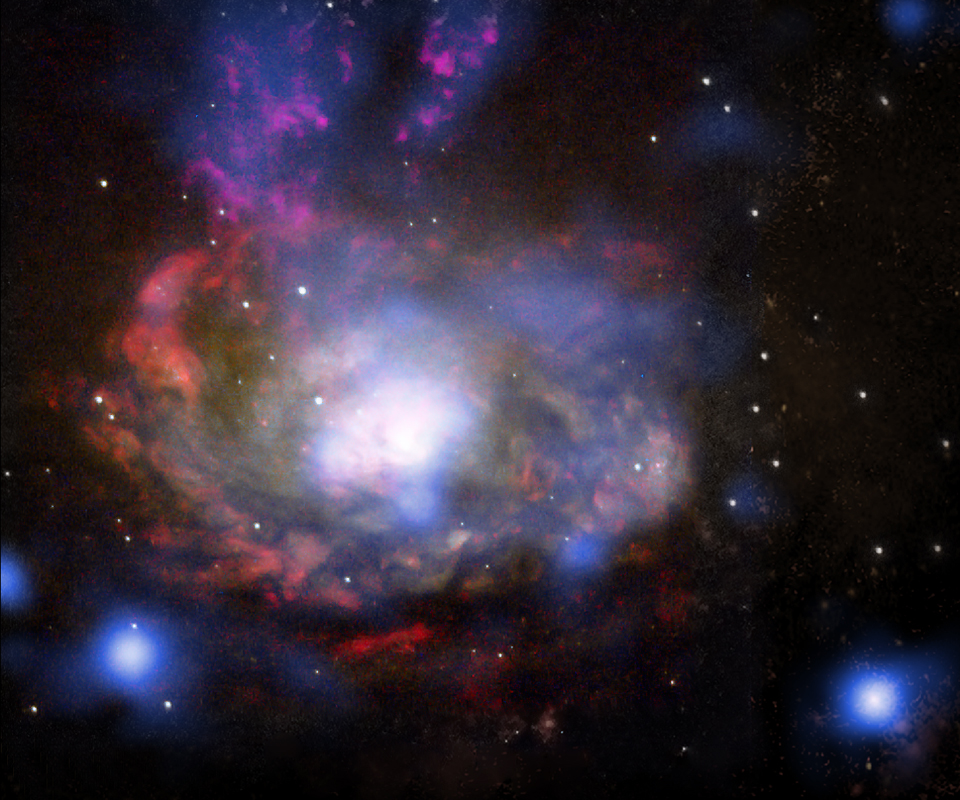[/caption]
Back in 2001, astronomer Franz Bauer noticed a bright, variable source in the Circinus spiral galaxy, using NASA’s Chandra X-ray Observatory. Although the source displayed some exceptional properties Bauer and his Penn State colleagues could not identify its nature confidently at the time. But now, seven years later Bauer and his team have confirmed this object was a supernova. By combining online data in the public archives from 18 different ground- and space-based telescopes, one of the nearest supernovae in the last 25 years, SN1996cr, has finally been identified. “It’s a bit of a coup to find SN 1996cr like this, and we could never have nailed it without the serendipitous data taken by all of these telescopes. We’ve truly entered a new era of ‘internet astronomy’,” said Bauer.
Because this object was found in an interesting nearby galaxy, the public archives of these telescopes contained abundant observations. Clues from a spectrum obtained by ESO’s Very Large Telescope led Bauer and his team to start the real detective work of searching through data from various telescopes.
The data show that SN 1996cr is among the brightest supernovae ever seen in radio and X-rays. Visible-light images from the archives of the Anglo-Australian Telescope in Australia show that SN 1996cr exploded sometime between 28 February 1995 and 15 March 1996, but it is the only one of the five nearest supernovae of the last 25 years that was not seen shortly after the explosion.
It also bears many striking similarities to the famous supernova SN 1987A, which occurred in a neighbouring galaxy only 160,000 light-years from Earth. Until now, it was the only known supernova with and X-ray output that increased over time. SN1996cr has the same attributes, but is much brighter.
“This supernova appears to be a wild cousin of SN 1987A,” says Bauer. “The two look alike in many ways, except this newer supernova is intrinsically a thousand times brighter in radio and X-rays.”

The combined data, in conjunction with theoretical work, have led the team to develop a model for the explosion. Before the parent star exploded, it cleared out a large cavity in the surrounding gas, either via a strong wind or from an outburst from the star late in its life. So the blast wave from the explosion itself could expand relatively unimpeded into this cavity. Once the blast wave hit the dense material surrounding SN1996cr, the impact caused the system to glow brightly in X-ray and radio emission. The X-ray and radio emission from SN 1987A is probably fainter because the surrounding material is less compact.
Astronomers think that both SN 1987A and SN 1996cr show evidence for these pre-explosion clear-outs by a star doomed to explode. Having two nearby examples suggests that this type of activity could be relatively common during the death of massive stars.
“Not only does our work suggest that SN 1987A isn’t as unusual as previously thought, but it also teaches us more about the tremendous upheavals that massive stars can undergo over their lifetimes,” said co-author Vikram Dwarkadas of the University of Chicago.
So all you internet astronomers, get out there and start clicking! Who knows what you’ll find.
Source: ESO


The link to the ESO release has a link to the May 6, 2008 paper by Bauer et al (arXiv:0804.3597v3). In it, I see no mention of detections of neutrinos (as was the case in SN 1987A) or detections by air shower arrays of ultra-high energy cosmic ray (UHECR) events correlating with SN1996cr. The paper gives the distance to the Circinus galaxy as 3.8 Mpc. This relatively close distance and the increased intensity of the SN itself may bode well for possible detections of neutrinos and/or UHECRs. Searching archival data from neutrino detectors & air-shower arrays may also prove fruitful.
I’m not an astronomer, but I came up with a theory based on what I have learned from UT and other sources. Like the group discussed in this article, I used public data to try and confirm my theory.
We know that galaxies collide, and the Milky Way has probably absorbed smaller galaxies in the past. Most, perhaps all, galaxies have a super massive black hole in the center. Therefore it’s possible that the Milky Way may contain a “rogue dwarf super-massive black hole” as the result of one of these collisions.
A tiny galaxy containing a couple tens of millions of stars would have a DSMBH (if I may coin a name for my proposed stellar object) on the order of 100,000 solar masses. It’s more likely that such a dense massive object would pass through the galaxy rather than be captured. If a RDSMBH currently resides within the Milky Way, then it might be passing through and leaving a trail of stars behind it.
I tried to locate my proposed object by querying the Sloan Digital Sky Survey for the top 1% blue shifted stars that were in close proximity to the top 1% red shifted stars. This might indicate an area where stars are orbiting around a rogue dwarf super massive black hole, some moving quickly in their orbit towards us and some moving quickly in the opposite direction.
My attempt was unsuccessful. This result may be because there is no such thing as a RDSMBH or because I don’t possess enough knowledge to properly query and interpret data from the SDSS.
In any case, the point of this long story is that we are in a Golden Age of discovery where ordinary people with absolutely nothing (including funding) but their passion for the subject can make great discoveries.
@RetardedFishFrog: I’m not sure of the physical description of a “rogue dwarf SMBH” or a “dwarf SMBH”, but whatever your hypothesis, SDSS DR6 only contains a small portion of the entire sky. In a few years, much deeper all-sky coverage awaits with surveys by LSST and PanStarrs 4. These much deeper, polychromatic sky surveys will surely prove a treasure trove to interested amateur-pro astronomers who wish to sift through their massive databases. Definitely, the Golden Age of discovery is just around the corner, for all with curiosity & patience!
“In any case, the point of this long story is that we are in a Golden Age of discovery where ordinary people with absolutely nothing (including funding) but their passion for the subject can make great discoveries.”
Hear hear! And it’s only going to get better and better. Think about upcoming survey telescopes such as LSST and the myriad of other similar (but smaller) observing programs, and the sheer volume of data they will amass on the sky each night. There are so many eyes on the sky now – and so many opportunities for the interested amateur to indulge their passion in whatever area of astronomy if they have the inclination and the time. Whether it be hunting through archival data from major observatories, or actively joining a pro-am observing collaboration, there has never been a better time to be a professional or amateur astronomer (unless you have no dark sky near you…).
The future looks bright indeed for astronomy (unless you happen to live in Britain, in which case your government is screwing your astronomy and science programs for funding so hard that the future looks bleak indeed).
One wanders if this could possibly be related to the behaviour of Eta Carinae.
While reading the paper mentioned in a previous post (arXiv:0804.3597v3) I came across an earlier paper by Bauer et al entitled “A Chandra study of the Circinus Galaxy point-source population” (arXiv:astro-ph/0104035 posted April 2, 2001) that explicitly mentions this Xray source (labeled Circinus X-2) as most likely being a young SNR in this galaxy. An earlier radio and Rosat X-ray look at this galaxy failed to see any object at the location of Cir X-2. The authors argued strongly that this evidence coupled with its’ Xray spectrum indicated this was a young SNR buried in an obscuring HII region in the Circinus Galaxy. Contrary to the ESO press release, these authors strongly suspected that this source was a young SNR! I guess it took 7 years to locate additional data to confirm this hypothesis, but I’m still not sure what all the fuss was about.